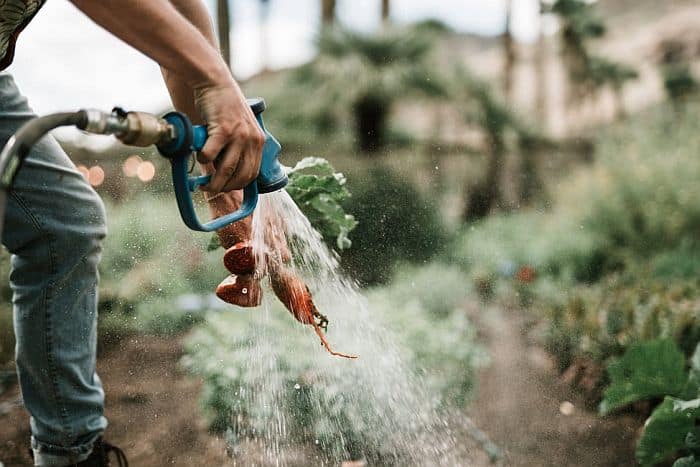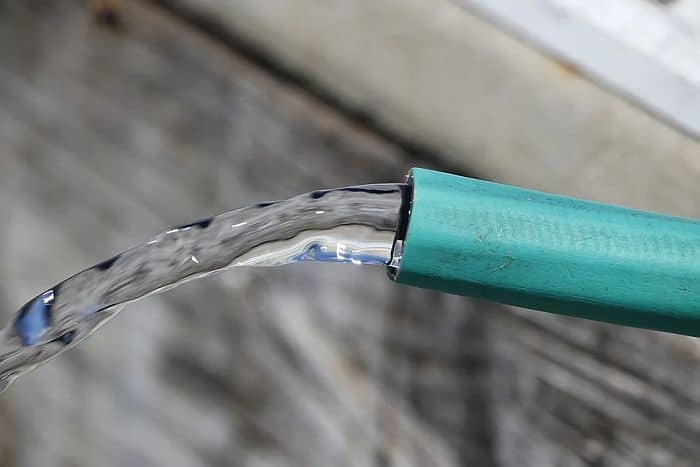It is not safe to drink from most garden hoses because of the contaminants that they release into the water. Many hoses contain harmful substances like bacteria, phthalates, bromine, BPA, and lead. However, some specialty hoses are safe to drink water from, but you must verify their safety first.
Have you ever been tempted to take a quick sip from your hose on a hot summer’s day? It can seem a lot more convenient than going into the house, especially when the water looks so cool and refreshing.
If so, you may be wondering, “Is it safe to drink from a garden hose?” Unfortunately, it usually isn’t because hoses can release harmful chemicals into the water.
In today’s guide, I’m going to walk you through the risks of drinking garden hose water and how you can keep yourself safe.
Contents
What Are The Risks Of Drinking From A Garden Hose?

Most garden hoses are not safe for drinking water because it’s not part of their design. The hose material itself and the brass fittings can release toxic chemicals into the water that you should not ingest.
Let’s take a look at all the potential risks of drinking water from a garden hose.
Bacteria
Drinking hose water increases your risk of ingesting harmful bacteria. Garden hoses create a breeding ground for some microorganisms because they often heat up in the sun and may have some water left over in them.
In some cases, the Legionella bacteria can grow inside garden hoses. It can enter your system from simply inhaling near the hose end or drinking the water.
This bacteria is very hazardous because it can cause Legionnaires disease. This disease attacks your lungs, causing pneumonia, inflammation, and sometimes a fever. Although you can treat this disease with antibiotics, it is sometimes deadly.
Phthalates
If your garden hose is made of plastic, like PVC, it may release phthalates into the water. Manufacturers put these chemicals, which are also called plasticizers, into plastic to make it stronger.
A 2016 study tested popular garden hoses and found that more than half contained very high levels of phthalates in their water.
Scientists are still conducting research, but studies suggest that phthalates may cause chronic disease or cancer. They may also cause less severe side effects like nausea, skin irritation, dizziness, and vomiting.
BPA
The same study that found phthalates also discovered BPA in water that sat inside hoses. Therefore, it could be present in the small amounts of water left behind after you finish watering your gardening.
BPA can be harmful because it is an industrial chemical. Studies showed that it could damage the brain and prostate and potentially cause high blood pressure, cardiovascular problems, and diabetes.
Lead
Lead is also commonly found in hose water. It is more prevalent when you have brass hose fittings, but PVC attachments can also contain elevated amounts. In the previously mentioned study, at least one-third of the tested hoses had more than 100ppm of lead.
The Centers for Disease and Control Prevention recommend that children, in particular, do not have exposure to more than 5 micrograms per deciliter (0.05ppm) of lead. Therefore, this is a very high level in many hoses.
High levels of lead can be harmful and even fatal to humans. It can cause short and long-term health effects, including:
- Lead poisoning
- Kidney and brain damage
- Miscarriages and stillbirths
- High blood pressure
- Kidney and heart diseases
- Fertility issues
- Cancers
Tin
PVC hoses may contain tin levels between 3000 and 4000ppm. This is problematic because higher than 200ppm of tin in food or drink is considered harmful to humans.
Tin protects the PVC from sunlight and heat, but it can also have negative health impacts. Tin can have a beneficial effect on the body, but it can be harmful in high doses and may cause side effects like nausea, gastrointestinal pain, and diarrhea.
Bromine
The garden hose study found high levels of bromine in more than one-third of the hoses tested. Each of the hoses was made of PVC and some registered bromine levels of more than 1000ppm.
Bromine is a common flame retardant that protects the hose against fire and increases its stability. If you ingest it in water, it can have the following health consequences:
- Gastrointestinal problems like nausea or vomiting
- Low blood pressure
- Kidney and brain damage
Washing Garden Vegetables With Hose Water – The Facts

Now that you know how many dangerous substances can be in hose water, you may be wondering if you can use it on your edible plants. By eating the fruits and vegetables that the water touches, are you also ingesting those substances?
Some findings suggest that vegetables can contain trace amounts of lead and phthalates. However, there is no conclusive proof that they come from the water and not other environmental factors.
In any case, I recommend choosing a drinking water-safe hose if you eat vegetables from your garden.
The 3 Best Drinking-Water Safe Garden Hoses

Some hoses have a drinking water safe label. This means that their fittings are tested lead-free, and they usually test for phthalate levels as well. Here are 3 drinking water safe garden hoses:
- Flexzilla
- Water Right
- Aqua Joe
However, this doesn’t necessarily mean that the hoses are free from bacteria. Therefore, there are still extra precautions you should take.
Steer clear of PVC, as it is the most likely to contain toxic chemicals. I recommend a natural rubber, stainless steel, or polyurethane hose.
You should opt for brass-free hose fittings. There are various options made of stainless steel, aluminum, or nickel. All of these metals are less likely to release lead into the water than brass.
You should also always carefully research your hose before buying it. Some brands may advertise themselves as drinking water-safe but still pose hazards.
If you ever see a label that mentions California Prop 65, you should avoid this hose. It means that it could cause cancer or birth defects in the long term.
How To Safely Drink Garden Hose Water
If you insist on drinking water from the hose, there are some steps you can take to reduce the risks of getting sick.
Let The Water Run

Let the water run through your hose for a few seconds before you drink it. This can flush out bacteria and other harmful substances. You can direct your hose onto the lawn or other plants while you wait for it to be safer to drink.
Keep It Out Of The Sun

Leaving your hose lying out in the sun can damage its exterior and also makes it more hazardous. The heat can increase bacterial growth inside the hose and cause chemicals to be released into the water.
I recommend investing in a hose reel and placing it inside your garage or storage shed. If you must keep it outside, try putting it under a tree or another entirely shady place.
Note that if the hose reel has an extension, it must be drinking water safe, too!
Keep It Away From Children And Pets

Children have more sensitive immune systems, so you should never allow your child to drink from a hose.
If your kid is old enough to understand, you can have a conversation about potential dangers. You should also supervise them when they are outside in the garden with the hose running.
If you use hose water to fill your pet’s drinking bowl, you should take the same precautions that you would for yourself. Let it run for a while before filling the bowl, and never use water that has been sitting inside a hot hose.
FAQs
Is Garden Hose Safe For Drinking Water?
Most garden hoses are not safe for drinking water because of the contaminants in the water. The water can contain harmful bacteria, BPA, lead, and other toxic substances. However, some brands are specially designed so that you can safely drink water from them.
Are Garden Hoses Toxic?
Garden hoses can be toxic because they release toxins into the water that passes through them. Lead, BPA, and phthalates are common contaminants that you can find in garden hose water. However, some brands and designs are much less toxic than others.
Are Stainless Steel Garden Hoses Drinking Water Safe?
Some stainless steel garden hoses have safe drinking water. Without the brass fittings, they are less likely to contaminate the water with lead or other toxins. If you want to choose a drinking water-safe stainless steel hose, the BEAULIFE 304 is an excellent option.
Are Rubber Hoses Safe To Drink From?
Natural rubber hoses may be safe to drink from. However, you should avoid PVC-based models because they can release harmful toxins called toxic plasticizers. If in doubt, you should always check that your particular hose has a drinking water-safe classification.
Can You Get Sick From Drinking From A Hose?
You can get sick from drinking from a garden hose. Most hoses do not deliver safe drinking water, so you may ingest a variety of bacteria and other toxic substances, like lead. These contaminants could make you ill in the short term and cause long-term health problems.
The Verdict: Is It Safe To Drink From A Garden Hose?
So, is it safe to drink from a garden hose? The answer is, “not really.” Garden hoses can provide homes for dangerous bacteria that can even attack your lungs. The hose material and fittings can also release lead, phthalates, tin, bromine, and BPA into the water.
Opt for a drinking water-safe hose and always let it run before you drink from it. You should also store it out of the sun and keep your kids away. By taking a few precautions, you can reduce the chances of getting sick.
Do you have any questions? Please let me know in the comments.

There is nothing that isn’t toxic, depending on the dose. Dose is measured by quantity of exposure over the body weight, factoring in time. If you’re running water through a hose, like watering plants, I sincerely doubt your exposure is at all significant. None of your data was gathered that way. Brass doesn’t have lead added to it, BTW, neither does plastic. If it’s there, it’s probably in lead soldered joints, which are nearly universal in residential plumbing. This is a silly, specious article. Toxicity reports should be written by toxicologists.
Flexzilla a best water-drinking hose? That is false, and indicates not only an ignorance on the subject that makes you repeat advertising fluff, but also lazyness in researching the subject. Had the author researched it, she would have discovered the 2016 Garden Hose Study of the Ecology Center of Michigan. Among many other hoses, the study analyzed the Flexzilla hose (made in Taiwan by the Jieh-Ming Plastics manufacturing company) and not only found that all of its layers are made of PVC, but detected multiple PHTHALATES in these layers at levels so high tot rate the hose as of “high concern.”